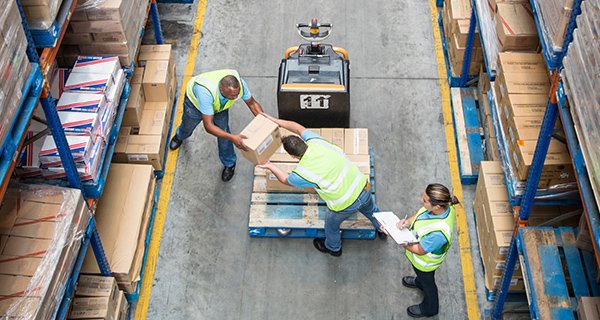Key takeaways
Reverse logistics in the pharmaceutical industry refers to the process of managing the return, disposal, and reuse of pharmaceutical products, including expired or damaged items, recalls, and surplus inventory.
- Technology plays a crucial role in optimizing pharmaceutical reverse logistics. By leveraging advanced software systems, data analytics, and automation, companies can streamline processes, reduce costs, and improve operational efficiency.
- Real-time tracking and tracing technologies enable better visibility and control over returned pharmaceutical products. This helps in identifying the root causes of product returns, such as expired or damaged items, and facilitates timely actions to minimize financial losses.
- Implementing barcode or RFID (Radio Frequency Identification) technology allows for accurate and efficient product identification during the reverse logistics process. This enables faster and more reliable sorting, verification, and inventory management.
- Data analytics and machine learning algorithms can analyze large volumes of data generated in reverse logistics to identify patterns, trends, and potential areas for improvement. This can lead to better decision-making, optimized inventory management, and enhanced customer service.
- Automation technologies, such as robotic process automation (RPA) and robotic sorting systems, can significantly improve the speed and accuracy of reverse logistics operations. These technologies can handle repetitive tasks, reduce manual errors, and increase overall productivity.
- Collaboration among stakeholders in the pharmaceutical supply chain is essential for efficient reverse logistics. Technology platforms that enable real-time communication and collaboration between manufacturers, distributors, retailers, and logistics providers can facilitate seamless returns and reduce delays.
- Compliance with regulatory requirements is critical in pharmaceutical reverse logistics. Technology solutions can help in documenting and tracking the chain of custody, ensuring proper disposal of hazardous materials, and meeting regulatory reporting obligations.
- Continuous monitoring and performance measurement are essential for optimizing reverse logistics. Key performance indicators (KPIs) and analytics dashboards can provide insights into process efficiency, cost savings, customer satisfaction, and environmental sustainability.
- Embracing innovative technologies and digital transformation is crucial for staying competitive in the pharmaceutical industry. Companies that leverage technology to optimize reverse logistics can achieve cost savings, improve customer satisfaction, and enhance their overall supply chain operations.

Challenges in Pharmaceutical Reverse Logistics
In reverse logistics, the pharmaceutical business encounters a number of difficulties. The correct way to get rid of unneeded or expired medication is one of the biggest obstacles. It is imperative to guarantee the safe and compliant disposal of these pharmaceuticals to avert any potential harm to the environment or public health. The handling of goods returns is another difficulty. It may be necessary to carefully analyze and evaluate the quality and condition of returned products in order for pharmaceutical enterprises to manage and process them properly. To reduce the danger of stock outs, efficient inventory management is also necessary.
overstocking or outs.
These difficulties may result in higher expenses, less effective operations, and even possible safety hazards for patients. But in order to overcome these obstacles and streamline pharmaceutical reverse logistics, technology has become a useful instrument.
Benefits of Technology Adoption in Reverse Logistics
The pharmaceutical business can reap various benefits from the integration of technology in reverse logistics. Improved product visibility and traceability throughout the reverse logistics process is one of the main advantages. Track-and-trace systems, made possible by technology, enable pharmaceutical businesses to precisely monitor the flow of their products from the point of return to the point of final disposal. By making process bottlenecks and inefficiencies easier to see, this enhanced visibility facilitates prompt remedial action.
The ability to use data analytics for decision-making is another advantage. Companies can learn more about the causes behind returns, spot trends, and make wise decisions to enhance product quality, packaging, or distribution procedures by gathering and evaluating data on product returns. Additionally, data analytics can be used to find possible places where expenses can be reduced and procedures can be enhanced.
Technology also makes it possible to incorporate automation into reverse logistics. Sorting, inspecting, and disposing of waste can all be streamlined by automation, which lowers the need for physical work and lowers the possibility of mistakes. Additionally, automation can improve inventory management’s speed and accuracy, guaranteeing ideal stock levels and lowering the risk of stock outs or overstocking.
Overall, the adoption of technology in reverse logistics can lead to improved operational efficiency, reduced costs, enhanced customer satisfaction, and increased compliance with regulatory requirements.
Implementation of Track-and-Trace Systems
Track-and-trace systems are one of the main technologies being used in pharmaceutical reverse logistics. Reverse logistics systems employ multiple technologies, including barcode scanning, RFID (Radio Frequency Identification), and serialization, to monitor the flow of goods during the process. Pharmaceutical businesses can have real-time visibility into the location and status of returned products by putting in place track-and-trace systems.
By giving precise information on the number, state, and location of returned goods, track-and-trace systems facilitate the effective administration of product returns. Through efficient resource allocation and prioritization, businesses are able to handle returns on time and dispose of them appropriately. In order to take preventative action against any possible problems or bottlenecks in the reverse logistics process, the systems also assist in recognizing them.
Track and trace systems also improve adherence to regulatory standards. They make it possible for businesses to keep precise records of returned goods, including the chain of custody, which is necessary for regulatory filings and audits. Pharmaceutical firms may stay out of trouble and keep their good name by making sure they are in compliance.
Overall, the implementation of track-and-trace systems in pharmaceutical reverse logistics improves visibility, efficiency, and compliance, leading to enhanced operational performance.
Utilizing Data Analytics for Decision Making
Pharmaceutical reverse logistics can be optimized with the use of data analytics. Companies can obtain important insights into the causes of returns, spot trends, and make data-driven decisions to enhance their procedures by gathering and evaluating data on product returns.
Finding the main reasons behind product returns is one of the most important applications of data analytics. Through data analysis of return causes, businesses can pinpoint frequent problems like product flaws, improper packaging, or mishandled delivery. Corrective measures, such raising the quality of the product, strengthening the supply chain, or improving packaging design, can be implemented with the use of this information.
Inventory management can be made more efficient with the use of data analytics. Businesses are able to modify their inventory levels by identifying patterns and trends in product returns through the analysis of return data. This lowers expenses, increases customer happiness, and minimizes stock outs or overstocking.
Data analytics can also be utilized to find possible places where expenses can be reduced and procedures can be enhanced. Through the examination of information on return processing durations, transportation expenses, and disposal techniques, businesses can pinpoint inadequacies and execute strategies to optimize their reverse logistics operations.
In conclusion, businesses can enhance overall operational performance, streamline procedures, and make data-driven decisions by implementing data analytics in pharmaceutical reverse logistics.
Integration of Automation in Reverse Logistics
Automation plays a crucial role in streamlining pharmaceutical reverse logistics. By integrating automation technologies, such as robotics and machine learning, companies can automate various tasks and processes, improving efficiency and reducing the risk of errors.
One of the key areas where automation can be applied is in sorting and inspection of returned products. Automated sorting systems can quickly and accurately categorize returned products based on their condition, expiry date, or other parameters. This helps in prioritizing the processing of returns and ensuring timely disposition.
Automation can also enhance the speed and accuracy of inventory management. Automated systems can track and manage inventory levels in real-time, ensuring optimal stock levels and minimizing the risk of stock outs or overstocking. This helps in reducing costs and improving customer satisfaction.
Furthermore, automation can improve the disposal process of expired or unused medications. Automated systems can safely and efficiently dispose of medications, ensuring compliance with regulations and minimizing the risk of environmental contamination.
In conclusion, the integration of automation technologies in pharmaceutical reverse logistics enhances efficiency, reduces errors, and improves overall operational performance.
conclusion
In conclusion, optimizing pharmaceutical reverse logistics with technology offers significant benefits for the industry. By leveraging advanced software systems, data analytics, and automation, companies can streamline processes, reduce costs, and improve operational efficiency. Real-time tracking and tracing technologies, barcode or RFID technology, data analytics, and automation all play critical roles in optimizing reverse logistics operations. Collaboration among stakeholders and compliance with regulatory requirements are also essential components. Embracing innovative technologies and digital transformation is key to staying competitive in the pharmaceutical industry. By optimizing reverse logistics with technology, companies can achieve cost savings, improve customer satisfaction, and enhance overall supply chain operations. As the industry continues to evolve, it is crucial for pharmaceutical companies to prioritize technology-driven solutions to maximize the benefits of reverse logistics.

FAQ
How can technology enhance reverse logistics?
Technology can enhance reverse logistics in several ways:
- Automation: Technology enables the automation of reverse logistics processes, such as return initiation, product inspection, and disposition. This streamlines operations, reduces manual effort, and improves efficiency.
- Tracking and Visibility: Advanced tracking technologies, like RFID and barcode systems, enable real-time visibility of returned products throughout the reverse logistics chain. This helps monitor the status, location, and condition of items, enhancing transparency and accountability.
- Data Analytics: Technology facilitates the collection, analysis, and interpretation of data related to reverse logistics. Analyzing this data helps identify patterns, root causes of returns, and areas for improvement, leading to better decision-making and optimized processes.
- Reverse Supply Chain Management Systems: Specialized software systems provide end-to-end management of reverse logistics, including return authorization, product disposition, and inventory management. These systems streamline operations, improve traceability, and enable effective collaboration among stakeholders.
- Customer Engagement: Technology enables effective communication and engagement with customers during the reverse logistics process. Online portals, chatbots, and self-service platforms facilitate easy return initiation, status updates, and resolution, leading to enhanced customer satisfaction.
- Refurbishment and Remanufacturing: Advanced technologies, such as 3D printing and repair automation systems, enable efficient refurbishment and remanufacturing of returned products. This reduces waste, extends product lifecycles, and enhances sustainability in reverse logistics.
- Reverse Logistics Analytics: Utilizing big data analytics and machine learning algorithms, technology can provide insights into optimizing reverse logistics processes. It helps identify cost-saving opportunities, predict demand for returned products, and optimize routing and transportation.
How do you optimize reverse logistics?
- Efficient Return Authorization: Implement a well-defined and user-friendly return authorization process. Simplify return initiation, provide clear instructions, and minimize unnecessary steps to ensure a smooth and efficient return process.
- Centralized Return Centers: Establish centralized return centers or consolidation points to consolidate returned products from various channels. This enables better control, improved inspection, and efficient processing of returns.
- Effective Product Inspection: Invest in efficient product inspection mechanisms to quickly assess the condition and determine the appropriate disposition of returned items. This helps identify salvageable products for resale, refurbishment, or remanufacturing.
- Streamlined Disposition Strategies: Develop effective strategies for product disposition. Optimize decisions on whether to refurbish, repair, recycle, resell, or dispose of returned products based on factors like cost, condition, market value, and customer demand.
- Inventory Management: Implement robust inventory management systems to track and manage returned products. This ensures accurate visibility of returned inventory, reduces excess inventory, and enables timely decision-making on inventory disposition.
- Collaboration and Partnerships: Foster strong relationships with suppliers, vendors, and service providers. Collaborate closely with them to streamline reverse logistics processes, share information, and leverage their expertise in managing returns effectively.
- Data Analytics and Continuous Improvement: Leverage data analytics to gain insights into return patterns, root causes, and opportunities for improvement. Analyze data to identify trends, optimize processes, and make informed decisions for enhancing reverse logistics operations.
- Customer Communication and Engagement: Establish effective communication channels with customers throughout the return process. Provide clear return policies, timely updates on return status, and prompt resolution of customer concerns to enhance satisfaction and loyalty
What is reverse logistics in pharmaceutical industry?
Product Returns: Reverse logistics in the pharmaceutical industry involves managing product returns, which can include expired, damaged, or recalled products. These returns need to be properly documented, inspected, and disposed of in compliance with regulatory guidelines.
- Recall Management: In the event of a product recall due to safety concerns or quality issues, reverse logistics plays a crucial role in efficiently retrieving the affected products from the market. This involves coordinating the recall process, managing communication with stakeholders, and ensuring proper handling and disposal of the recalled products.
- Expiry Management: Reverse logistics also includes managing products that have reached their expiration dates. Proper handling and disposal of expired pharmaceuticals are essential to prevent their inappropriate use and potential harm to patients.
- Disposal and Destruction: Reverse logistics in the pharmaceutical industry encompasses the proper disposal and destruction of pharmaceutical products to ensure they do not pose any safety or environmental risks. This involves following specific guidelines and regulations for safe disposal, such as incineration or other approved methods.
- Product Integrity and Chain of Custody: Reverse logistics in the pharmaceutical industry emphasizes maintaining product integrity and chain of custody throughout the return and disposal process. This includes proper documentation, tracking, and maintaining a secure and controlled environment to prevent diversion or tampering.
- Regulatory Compliance: Reverse logistics in the pharmaceutical industry is subject to various regulatory requirements, such as those set by regulatory bodies like the FDA (Food and Drug Administration) or other relevant authorities. Compliance with regulations ensures that the return,
How can advancements in technology and data analytics be leveraged to optimise logistics management for enhanced efficiency in operations?
Advancements in technology and data analytics can be leveraged to optimize logistics management and enhance operational efficiency in several ways:
- Real-time Tracking and Visibility: Implementing technologies like GPS tracking, RFID, and IoT sensors allows for real-time tracking of shipments, inventory, and vehicles. This provides visibility into the entire supply chain, enabling better planning, monitoring, and decision-making.
- Predictive Analytics: By analyzing historical data and applying predictive analytics algorithms, organizations can forecast demand, optimize inventory levels, and anticipate supply chain disruptions. This helps in improving resource allocation, reducing stockouts, and enhancing overall operational efficiency.
- Route Optimization: Advanced route optimization algorithms utilize data on traffic patterns, weather conditions, and delivery priorities to generate optimal delivery routes. This minimizes transportation costs, reduces delivery time, and enhances resource utilization.
- Warehouse Automation: Technologies like robotics, automation, and AI-powered systems can streamline warehouse operations. Automated picking, sorting, and inventory management systems improve accuracy, speed up processes, and optimize space utilization.
- Supply Chain Collaboration Platforms: Cloud-based collaboration platforms facilitate seamless communication and information sharing among stakeholders in the supply chain. This improves coordination, reduces lead times, and enables real-time decision-making across the network.
- Demand Sensing and Demand-Driven Planning: Leveraging data analytics and machine learning, organizations can better understand market demand patterns, consumer behavior, and trends. This enables demand-driven planning, leading to improved inventory management, reduced stockouts, and enhanced customer satisfaction.
- Data-Driven Performance Measurement: Using key performance indicators (KPIs) and analytics dashboards, organizations can monitor and measure logistics performance. This allows for identifying bottlenecks, areas of improvement, and making data-driven decisions to optimize operations.
- Autonomous Vehicles and Drones: The use of autonomous vehicles and drones in logistics can streamline last-mile delivery, reduce transportation costs, and improve delivery speed. These technologies leverage data and automation to enhance efficiency and safety.
- Blockchain Technology: Blockchain offers secure and transparent record-keeping, enabling traceability and accountability across the supply chain. It enhances trust, reduces fraud, and simplifies processes like contract management and payment settlements.
- Continuous Improvement and Optimization: By leveraging technology and data analytics, organizations can continuously monitor, analyze, and optimize logistics operations. This iterative approach ensures ongoing improvement, cost reduction, and increased efficiency.
Hope this article was helpful for more check out our previous blog post by clinking here

